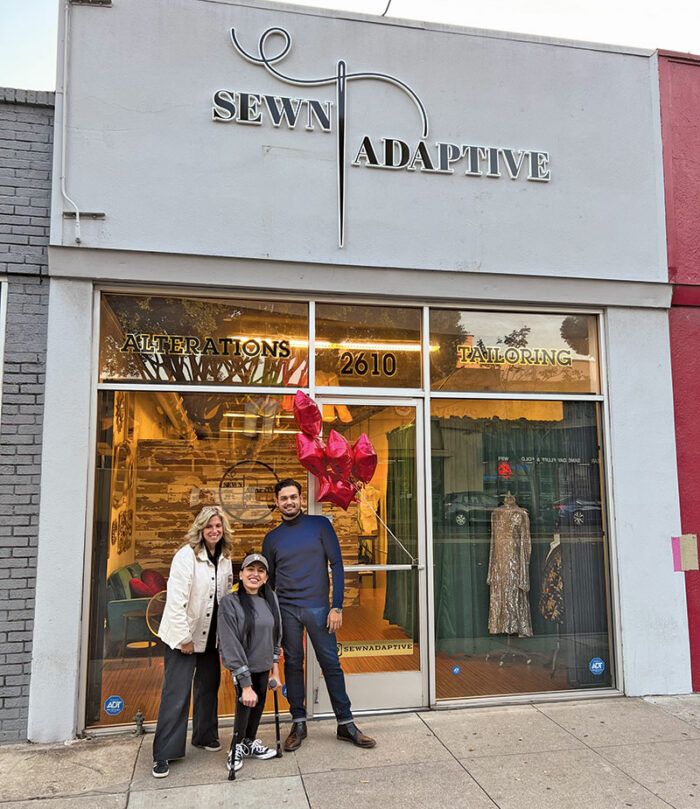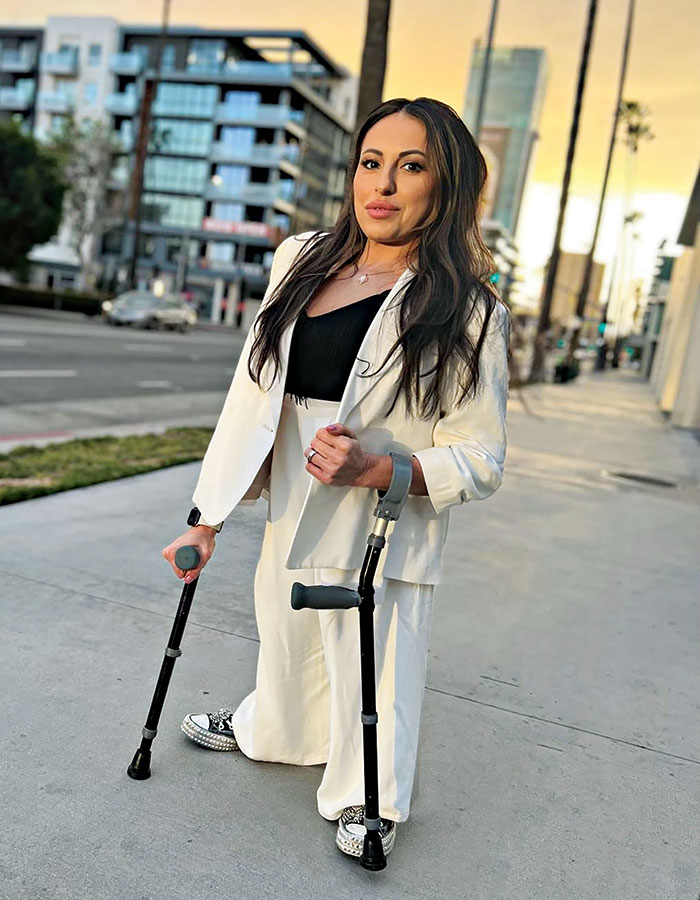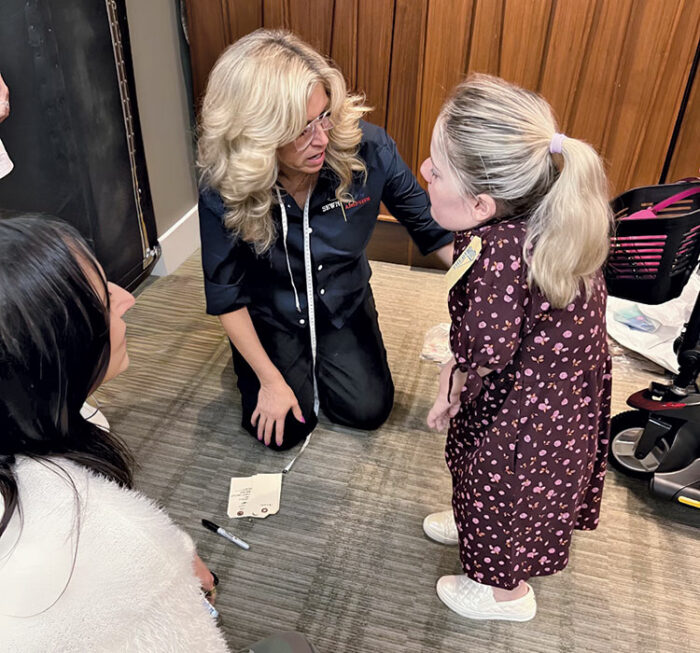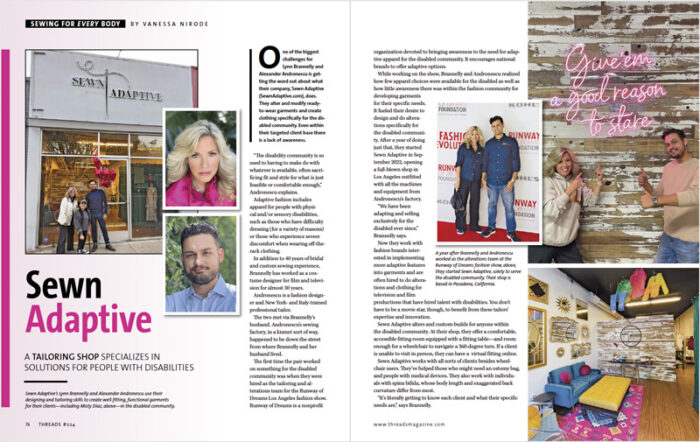Sewn Adaptive Customizes Clothes for People with Disabilities
Two tailors focus on fit, function, and personal style
One of the biggest challenges for Lynn Brannelly and Alexander Andronescu is getting the word out about what their company, Sewn Adaptive (SewnAdaptive.com), does. They alter and modify ready-to-wear garments and create clothing specifically for the disabled community. Even within their targeted client base there is a lack of awareness.
“The disability community is so used to having to make do with whatever is available, often sacrificing fit and style for what is just feasible or comfortable enough,” Andronescu explains.
Adaptive fashion includes apparel for people with physical and/or sensory disabilities, such as those who have difficulty dressing (for a variety of reasons) or those who experience severe discomfort when wearing off-the-rack clothing.
In addition to 40 years of bridal and custom sewing experience, Brannelly has worked as a costume designer for film and television for almost 30 years.
Andronescu is a fashion designer and New York- and Italy-trained professional tailor.
 |
 |
The two met via Brannelly’s husband. Andronescu’s sewing factory, in a kismet sort of way, happened to be down the street from where Brannelly and her husband lived.
The first time the pair worked on something for the disabled community was when they were hired as the tailoring and alterations team for the Runway of Dreams Los Angeles fashion show. Runway of Dreams is a nonprofit organization devoted to bringing awareness to the need for adaptive apparel for the disabled community. It encourages national brands to offer adaptive options.

While working on the show, Brannelly and Andronescu realized how few apparel choices were available for the disabled as well as how little awareness there was within the fashion community for developing garments for their specific needs. It fueled their desire to design and do alterations specifically for the disabled community. After a year of doing just that, they started Sewn Adaptive in September 2022, opening a full-blown shop in Los Angeles outfitted with all the machines and equipment from Andronescu’s factory.
“We have been adapting and selling exclusively for the disabled ever since,” Brannelly says.
Now they work with fashion brands interested in implementing more adaptive features into garments and are often hired to do alterations and clothing for television and film productions that have hired talent with disabilities. You don’t have to be a movie star, though, to benefit from these tailors’ expertise and innovation.
Sewn Adaptive alters and custom-builds for anyone within the disabled community. At their shop, they offer a comfortable, accessible fitting room equipped with a fitting table—and room enough for a wheelchair to navigate a 360-degree turn. If a client is unable to visit in person, they can have a virtual fitting online.
Sewn Adaptive works with all sorts of clients besides wheelchair users. They’ve helped those who might need an ostomy bag, and people with medical devices. They also work with individuals with spina bifida, whose body length and exaggerated back curvature differ from most.
“It’s literally getting to know each client and what their specific needs are,” says Brannelly.
Common types of alterations
There are some common alterations Sewn Adaptive performs on a regular basis.
For wheelchair users, the tailors often add a waist dart to get rid of the excess fabric that bunches in the lap area. They also alter or build custom jeans and trousers. Plus, they make high-low shirt hems: alterations that make shirts appear full length without excessive wrinkles when the wearer is sitting. To achieve this, they hem the shirt high in front but low enough in the back that it doesn’t create the impression of a cropped top.

For those with medical devices or prosthetics, Brannelly and Andronescu add zippers to pant inseams for easy accessibility. They also replace a lot of buttons with magnetic closures, hook-and-loop closures, or snaps.
For people with feeding tubes, Brannelly and Andronescu create hidden inside pockets, “almost like a maternity panel on the inside of a pair of pants or a shirt that nobody can see, but the user can have the bag rest in there,” Andronescu explains. For infants on feeding tubes, they fabricate a discreet welt opening, like the one you would do for a welt pocket, on onesies. These can’t really be seen, but they enable the parent to feed their child without having to completely undress them.

For easier dressing, they also often install magnetic separating zippers, which have a fatter hook system at the bottom than a conventional zipper. When you bring the two sides close enough, they hook together automatically, with little effort required from the user.
“After latching automatically, all you have to do is pull upward. We do that alteration for people with dexterity challenges, or sometimes for older folks or a very young child,” Brannelly says.
Sourcing notionsThe magnetic zippers that Sewn Adaptive uses often are sourced from the sportswear company Under Armour. They manufacture a chunky version made from black molded plastic that’s “immensely strong and really durable,” says Andronescu. Invented by Scott Peters, magnetic zippers were adapted for skiers who often wear large gloves that make it difficult to zip their parkas. A magnetic zipper was the solution. YKK, the world’s largest zipper manufacturer, offers more variety, says Andronescu. “But just trying to get them to develop that fully is tricky because, as far as the state of the adaptive sewing world goes, everything is extremely slow-moving.” He and Brannelly discuss this obstacle often during meetings about the state of the adaptive world. |
More complex projects
Sewn Adaptive’s more complex modifications and alterations involve customizing existing garments. Just as it does for nondisabled persons, to achieve a well-fitting result usually requires individualized alterations and modifications.
For example, they recently added an inconspicuous gusset to a bridesmaid dress to accommodate the wearer.
What they love about their work
Andronescu loves the constant change that working with the disabled community provides. When somebody walks into their shop, it’s always a new challenge.

“I get to explore—whether it’s a new patternmaking method or really changing the way things are shaped, or creating something new,” he explains.
Plus, he adds, he enjoys learning new things from Brannelly, as they come from different backgrounds (factory sewing versus costuming for film and television).

For Brannelly, she loves getting to make a difference. As a neurodiverse person with a dyslexia diagnosis, she understands not fitting into certain predetermined molds set by society.
Whatever they do and for whomever they are doing it, it is clear Brannelly and Andronescu care a great deal. As Brannelly says, “I am committed to making sure that people who otherwise have been othered, are seen and represented.”

How to enlist their servicesSewn Adaptive schedules in-person appointments and online virtual fittings. The client always has the option of sending their clothing through the mail. “If it’s somebody we met online, you can send through the mail or come in and vice versa,” they say. Find out more at SewnAdaptive.com. |
—Vanessa Nirode is a writer, patternmaker, and tailor based in New York City.
Photos: courtesy of Sewn Adaptive.
To view whole PDF, click on the “view PDF” button below:
From Threads #224
View PDF































Log in or create an account to post a comment.
Sign up Log in